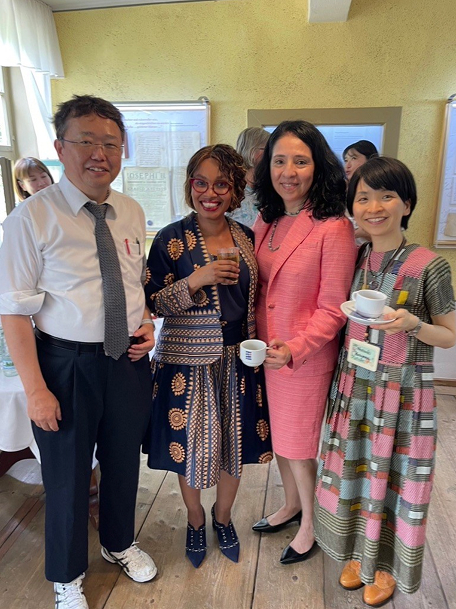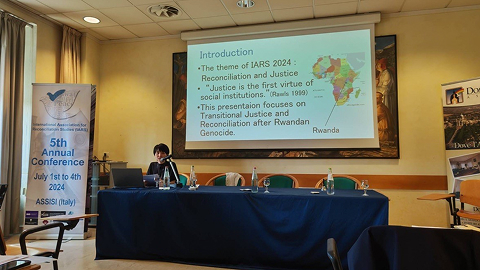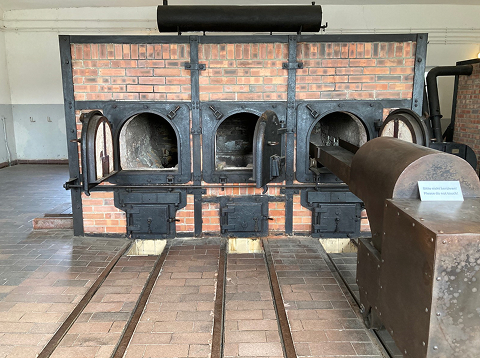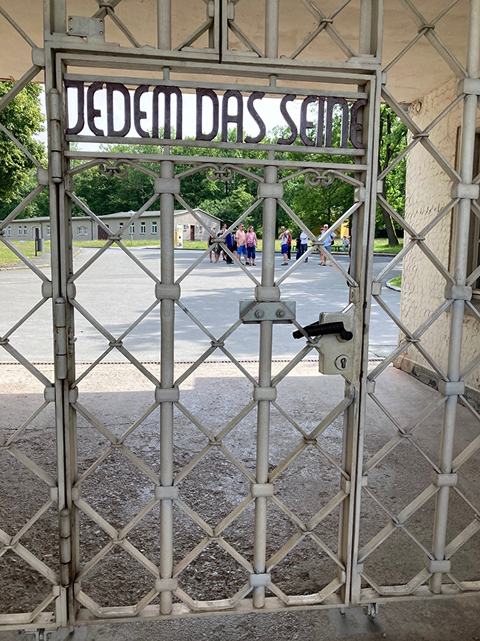This training program was organized by the project of ‘Exploring International Reconciliation Studies based on Universal Values and Collective Memory.’ We left Japan on 26 June 2024, stayed in Germany from 27-30 June, Italy from 1-6 July and returned to Japan on 7 July. In Germany, we participated in the JCRS TURNS 11. It was the international meeting for 11th anniversary of the Jena Center for Reconciliation Studies (JCRS) of the Friedrich Schiller University Jena (University of Jena). In Italy, we participated in the 5th Annual Conference of the International Association for Reconciliation Studies (IARS) in Assisi. I presented my research there.
Looking at the project that organized this training program, the university hosted the meeting and the conference that we attended, the key word is ‘reconciliation’. Most significantly, the training program gave me the opportunity to consider reconciliation and its opposite, violence. The following are my reflections on them.
I thought about reconciliation in the following research presentation given at the JCRS TURNS 11 (See figure 1). Christine Schliesser, the research fellow at the Albert-Ludwigs-Universität Freiburg presented her research ‘The Role of Religion in Post-Genocide Rwanda’s Quest for Reconciliation.’ The presentation was about reconciliation between victims and perpetrators of genocide in Rwanda.

Figure 1. JCRS TURNS 11, 30/6/2024.
First, I make reference to Rwanda to understand the contents of Schliesser’s presentation. The Republic of Rwanda is located inland eastern Africa. In 1994 Hutu hardliners committed genocide against Tutsi. The victims were over 500,000, and many Hutu and Twa who opposed the genocide were also killed. Tutsi, Hutu and Twa originally represented cattle-herders, peasants, and pygmy, but they were fixed as ethnic groups under Belgium mandate territory.
Schliesser’s research focused on attempts to use faith to restore the ethnic divisions caused by Rwandan genocide. She presented the following case studies. First, a case of restored relationships based on the Christian doctrine of forgiveness and reconciliation. Second, a case where genocide victims and perpetrators gave cows each other based on traditional culture. In Rwanda, cows have been valued since the age of the kingdom. Therefore, a relationship in which cows are given to each other is a sign of trust.
The cases presented by Schliesser demonstrate successful reconciliation at the individual level. However, there are cases where relationships are not restored. This is because I have also studied Rwandan Genocide and interviewed victims and perpetrators. Many of the cases I collected demonstrated the difficulties of reconciliation at the individual level. My research will be discussed further below.
In relation to Schliesser’s presentation of faith, I would like to mention one case I heard in Rwanda. A Rwandan priest I met stated the bereaved families of victims of the genocide as follows. “The religious bereaved try to follow God’s teachings. They try to forgive perpetrators and reconcile. But how hard is that for the bereaved?”
To add to the priest’s statement, victims were murdered by people who had been involved and lived in the same village before the genocide. Murderers return to the village after serving their sentences. The bereaved families and perpetrators are forced to meet and live with each other in daily life. The priest stated, “When I consider the feelings of the bereaved, it would be hard to advise them to reconcile with perpetrators”. This case illustrates the limitations of the role of faith.
There was no question and answer session after Schliesser’s presentation, so we could not discuss reconciliation. Thus, I spoke to her directly about this after the JCRS TURNS 11 and received the following response. She replied that forgiveness and reconciliation is about being released from the mental burdens carried by the bereaved, and continuing to faith is about believing that this will be possible one day. As the title of her presentation is ‘the quest of reconciliation’, her argument is that even if they are halfway there now, when they continuing to faith, they will reconcile one day.
Schliesser’s argument, like that of Rwandan researcher Phil Clark, assumes that victims and perpetrators of Rwandan Genocide can be reconciled. However, my argument is that non-parties to the genocide should be cautious in discussing reconciliation. This is because, in my view, the non-parties’ argument that reconciliation is possible would force reconciliation to parties who cannot reconcile, as the priest referred to.
At IARS in Assisi, Italy, I presented my research on the difficulties of reconciliation between victims and perpetrators of Rwandan Genocide, based on interviews I conducted in local villages (See figure 2). This year marks 30 years since the 1994 Rwandan Genocide, and throughout that time, reconciliation has been tried in national, local and individual levels. However, the system of compensation that I have focused on creates a structure that forces victims to give up compensation. It also makes reconciliation in the individual level even more difficult.

Figure 2. my research presentation at IARS, Italy, 3/7/2024.
Here is the content of my presentation. I have studied ‘Gacaca courts’ (Inkiko Gacaca in Kinyarwanda), which tried crimes of civilians who participated in Rwandan genocide. About 12,000 courts were set up throughout the country from 2002 to 2012. Residents without legal qualifications were elected as judges, and all residents aged 18 years over were obliged to administer Gacaca courts.
Gacaca courts ordered compensation for theft and damage to property. However, the amount of compensation was huge, and most perpetrators could not pay them. Then perpetrators asked victims directly to reduce or exempt compensation. Most victims had to take perpetrators’ economic circumstances into account and agree to perpetrators’ offers. As a result of this, victims cannot receive compensation and remain poor. For most victims, it is too hard to forgive and reconcile with perpetrators because victims have lost both their families and properties in the genocide and have not even received compensation. I have interviewed a total of 97 victims, perpetrators and Gacaca judges, accessed closed records of Gacaca courts which are kept at National Police Headquarters in the capital Kigali, and identified the actual situation of compensation. In carrying out this research from 2014 to 2016, I got the official permissions from the Ministry of Education in Rwanda and the National Commission for the Fight Against Genocide (CNLG) which is the government organization with jurisdiction over records of Gacaca Courts.
I received the following comments from listeners to my presentation. First, although compensation is essential for reconciliation, the actual situation is very hard as perpetrators’ wives and children must compensate instead of perpetrators who are in prison. Next, a researcher from Burundi added that conflicts have also occurred in Rwanda’s neighboring countries of Burundi, Uganda and the Democratic Republic of Congo (DRC). He explained that these countries, like Rwanda, face the same problems of reconciliation and compensation. Another researcher from Burundi was interested in the fact that my research was inspired by metaphors of Kinyarwanda, the Rwandan language. She evaluated that my efforts to learn Kinyarwanda in villages generated the idea of my research. Another researcher recognized that Gacaca courts had facilitated reconciliation between victims and perpetrators, but she changed her perception after hearing my presentation. She assessed that I had researched the details of compensation for two years.
Next, I detail the presentation which I was interested in. Charles Davidson, the associate professor at George Mason University, presented his research ‘Forgiveness and Reconciliation in Community-Based Peacemaking’. Davidson is using research funding obtained from the university to mediate among more than 50 armed groups, disarm combatants and create jobs for ex-combatants in Eastern part of DRC, which is still in conflict.
This support can backfire and cause conflicts if funding is not allocated properly. Davidson self-deprecatedly stated, “I usually call myself a peacebuilder, but when I was confronted with an AK47 rifle by combatants in the field, I was just a chicken”. This statement shows that his activities risk his own life. Thus, I wanted to know why he went to such lengths to continue supporting combatants.
I asked Davidson directly what his own view of reconciliation and received the following answer. He stated, “By nature, combatants don’t want to be combatants. There are no jobs in conflict areas, and they have no other means of earning a living than being combatants. We have to create the environment where young people don’t have to pick up weapons.” Davidson recognizes that this support will lead to reconciliation in communities.
Participating in IARS made me aware of what reconciliation means for each researcher, and I got the opportunity to apply IARS findings to my own research.

Figure 3. the ovens which cremated dead bodies, Germany, 29/6/2024.
Finally, I would like to describe violence as the opposite of reconciliation. I thought about this because we visited the Buchenwald Concentration Camp in Germany. This concentration camp was built in 1937. 280,000 persons from 50 nations were sent to this camp including political opponents to the Nazi regime, so-called asocials and criminals, homosexuals, Jehovah’s Witnesses, Jews, Sinti and Roma. The Schutzstaffel (SS) forced the inmates to work, conducted human experimentation, and murdered them. About 56,000 human beings met their deaths here.
The concentration camp is left in order to recognize and not repeat past mistakes. In this camp, there are the execution site and crematorium. The inmates had been hanged in the underground execution site, and dead bodies of the inmates were lifted above ground. They were cremated by the ovens which were constructed by the private company based on trash incinerators (See figure 3) . I was told the reasons dead bodies were cremated instead of being buried was to clear the huge numbers of dead bodies quickly. And the SS did not want to touch dead bodies of the inmates who had died from human experimentation or disease.
The following inscription caught my attention the most. ‘Jedem Das Seine’ (To each his own) is inscribed in red on the gate separated the inmates’ camp from the SS area (See figure 4). It was a Roman legal maxim expressing the universal right to equality and justice and was also inscribed on the highest Prussian decoration. First, I was uncomfortable with the fact that this maxim was displayed in the concentration camp. The indescribable brutality crimes that were perpetrated here were completely incompatible with the equality and justice that this maxim originally meant.
Why was this maxim inscribed on the gate in watermarked text to be visible to the inmates? It was my biggest question. ‘Jedem Das Seine’ is also translated as ‘within one’s means.’ Did the Nazi consider that interning criminals and Jews in the concentration camps was ‘within their means’? Did the Nazi consider that the forced labor was ‘universal right’ of criminals and Jews? I think the Nazi dared to inscribe this maxim in order to justify their violence.

Figure 4. ‘Jedem Das Seine,’ the maxim is inscribed the gate of Buchenwald Concentration Camp, Germany, 29/6/2024.

